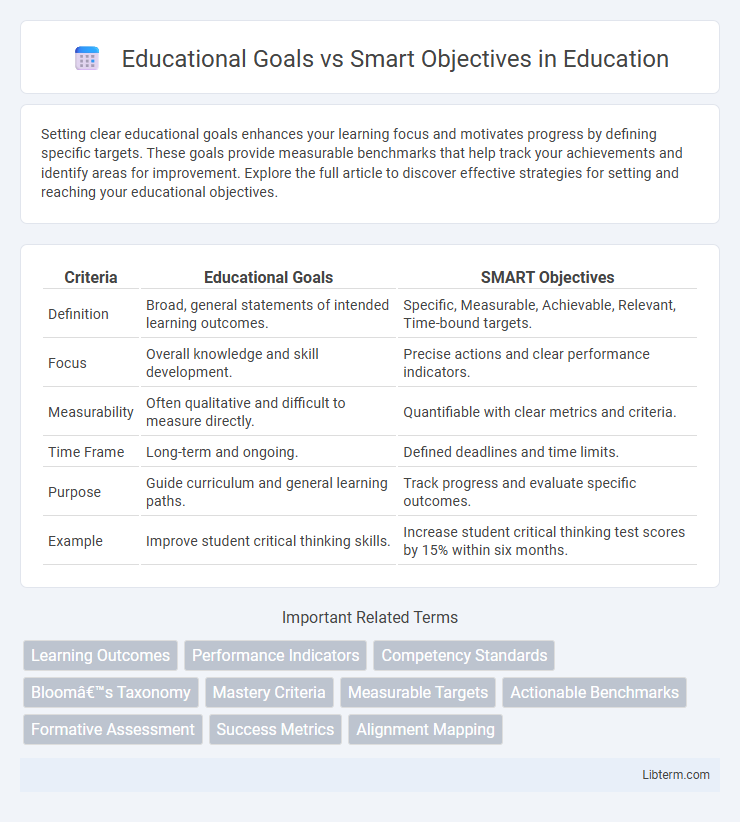Setting clear educational goals enhances your learning focus and motivates progress by defining specific targets. These goals provide measurable benchmarks that help track your achievements and identify areas for improvement. Explore the full article to discover effective strategies for setting and reaching your educational objectives.
Table of Comparison
| Criteria | Educational Goals | SMART Objectives |
|---|---|---|
| Definition | Broad, general statements of intended learning outcomes. | Specific, Measurable, Achievable, Relevant, Time-bound targets. |
| Focus | Overall knowledge and skill development. | Precise actions and clear performance indicators. |
| Measurability | Often qualitative and difficult to measure directly. | Quantifiable with clear metrics and criteria. |
| Time Frame | Long-term and ongoing. | Defined deadlines and time limits. |
| Purpose | Guide curriculum and general learning paths. | Track progress and evaluate specific outcomes. |
| Example | Improve student critical thinking skills. | Increase student critical thinking test scores by 15% within six months. |
Understanding Educational Goals
Educational goals provide a broad vision of desired learning outcomes, serving as foundational statements that guide curriculum development and instructional strategies. They encompass long-term aspirations such as fostering critical thinking, enhancing creativity, and promoting lifelong learning among students. Understanding educational goals is crucial because they set the overall purpose and direction before defining specific, measurable SMART objectives aligned with these overarching aims.
Defining SMART Objectives
SMART objectives are specific, measurable, achievable, relevant, and time-bound targets designed to provide clear direction and criteria for success in educational settings. Unlike broad educational goals, SMART objectives break down desired outcomes into actionable steps, enabling precise tracking of progress and accountability. This focus on specificity and measurability ensures that instructional strategies effectively align with student learning needs and institutional priorities.
Key Differences Between Goals and SMART Objectives
Educational goals provide broad, overarching aims that guide learning outcomes and long-term vision, whereas SMART objectives specify clear, measurable, achievable, relevant, and time-bound targets within those goals. Goals are qualitative and general, serving as guiding principles, while SMART objectives deliver precise criteria to assess progress and success. The key difference lies in the specificity and measurability, where SMART objectives translate abstract goals into actionable steps.
The Importance of Setting Educational Goals
Setting educational goals provides a clear direction for learning and helps prioritize essential skills and knowledge. These goals establish a broad vision that motivates and guides students, while SMART objectives break down this vision into specific, measurable, achievable, relevant, and time-bound steps. The importance of setting educational goals lies in fostering focus, enhancing motivation, and enabling continuous assessment of progress toward academic success.
The Role of SMART Objectives in Education
SMART objectives play a crucial role in education by providing clear, measurable, and attainable targets that guide both teaching and learning processes. Unlike broad educational goals, SMART objectives specify Specific, Measurable, Achievable, Relevant, and Time-bound criteria that enhance focus, motivation, and assessment accuracy. Implementing SMART objectives supports effective curriculum design, personalized instruction, and improved student outcomes through precise progress tracking and actionable feedback.
How to Formulate Effective Educational Goals
Effective educational goals are formulated by focusing on broad, long-term learning outcomes that align with the overall curriculum vision, emphasizing knowledge acquisition, skill development, and attitudinal growth. Clear, measurable criteria are essential for setting these goals to ensure they guide instructional planning and assessment frameworks while remaining adaptable to diverse learner needs. Incorporating learner-centered strategies and aligning objectives with standards like Bloom's Taxonomy enhances goal clarity and educational impact.
Steps to Creating SMART Educational Objectives
Creating SMART educational objectives involves specifying clear steps to enhance learning outcomes effectively. Begin by defining Specific goals that detail the desired student behavior or skill, ensuring clarity and focus. Next, establish Measurable criteria to track progress, set Achievable targets within realistic limits, ensure Relevance by aligning objectives with curriculum standards, and designate a clear Time frame for completion to maintain accountability.
Aligning Educational Goals With SMART Objectives
Aligning educational goals with SMART objectives enhances the clarity and measurability of learning outcomes by defining Specific, Measurable, Achievable, Relevant, and Time-bound targets. This approach ensures that broad educational goals translate into actionable steps with clear criteria for success, facilitating focused instruction and assessment. Integrating SMART objectives within educational frameworks promotes continuous improvement and accountability in academic performance.
Common Pitfalls in Setting Educational Goals and Objectives
Common pitfalls in setting educational goals and SMART objectives include vague or overly broad statements that lack clear criteria for success, hindering measurable progress. Goals often neglect alignment with student needs and institutional priorities, resulting in irrelevant or unattainable outcomes. Failure to incorporate specific, measurable, achievable, relevant, and time-bound (SMART) elements diminishes the effectiveness of objectives in driving targeted educational improvements.
Measuring Achievement: Tracking Progress of Goals and SMART Objectives
Measuring achievement in educational goals involves assessing broad, long-term outcomes such as student engagement and overall knowledge acquisition, while SMART objectives provide specific, measurable, attainable, relevant, and time-bound criteria that enable precise tracking of progress. Tracking progress for SMART objectives uses quantifiable data like test scores or assignment completion rates to monitor incremental improvements and adjust strategies promptly. Educational goals serve as overarching targets, but SMART objectives break these into actionable steps with clear metrics, ensuring systematic evaluation and effective achievement monitoring.
Educational Goals Infographic

 libterm.com
libterm.com